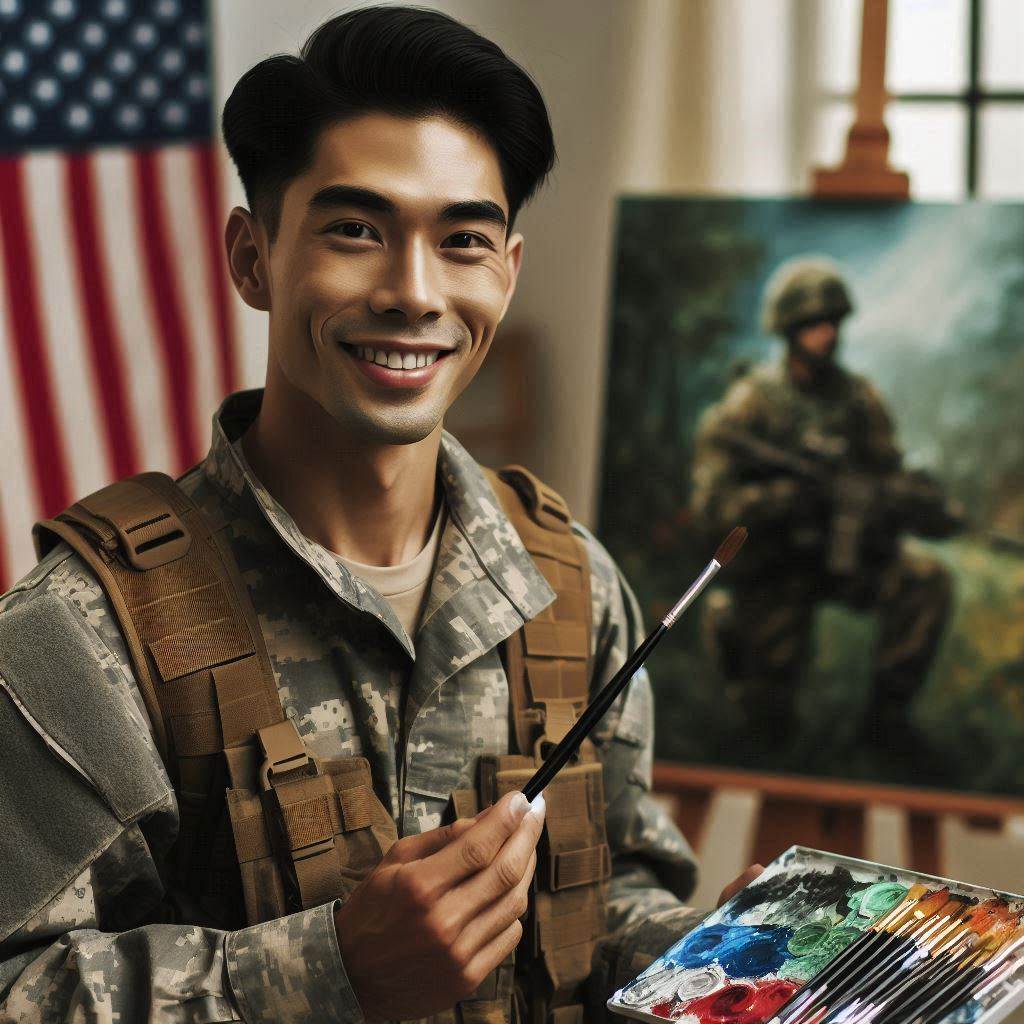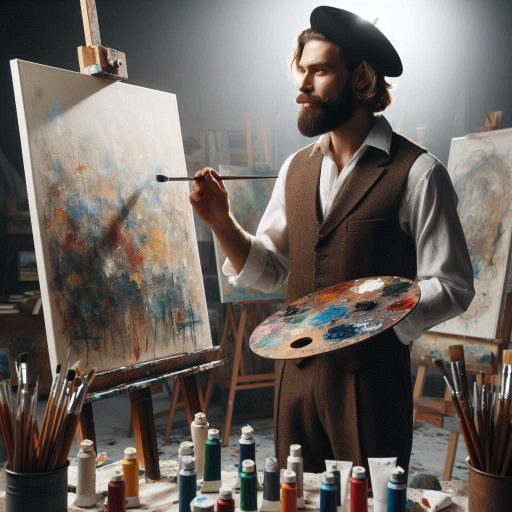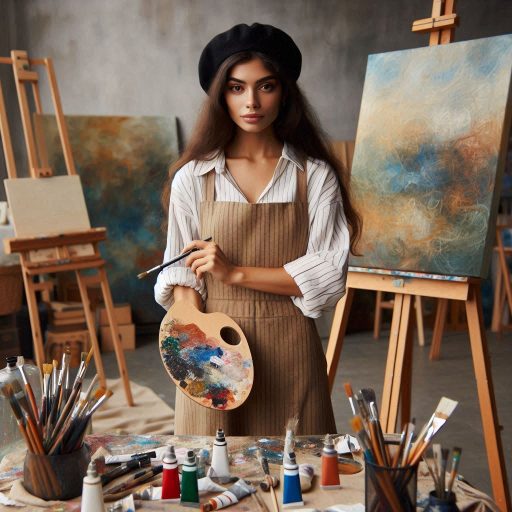Introduction
Art therapy is a powerful form of therapy that uses creative expression to promote mental health and overall well-being.
This therapeutic approach enables individuals to explore their emotions, reduce stress, and enhance self-awareness through various artistic activities such as painting, drawing, and sculpting.
Many studies highlight the effectiveness of art therapy in addressing various mental health challenges, including anxiety, depression, and trauma-related disorders.
By providing a non-verbal outlet for expression, art therapy helps individuals communicate feelings that may be difficult to articulate.
This blog post specifically focuses on the benefits of art therapy for veterans.
Many veterans experience unique challenges related to their service, including post-traumatic stress disorder (PTSD), depression, and difficulties reintegrating into civilian life.
These experiences can create barriers to emotional expression and understanding, making traditional talk therapies less effective for some veterans.
Art therapy offers an alternative approach that allows for deeper exploration of complex emotions through creativity.
Through creative expression, veterans can process their feelings, share their stories, and connect with others who have had similar experiences.
Art therapy fosters a supportive environment where individuals feel safe to explore difficult emotions and experiences without fear of judgment.
This therapeutic process encourages personal growth and resilience, helping veterans regain a sense of control over their lives.
Overview of art therapy
What art therapy is and how it differs from traditional talk therapy
Art therapy provides veterans with a unique outlet for emotional expression.
This therapeutic approach combines the creative process of making art with psychological support.
Unlike traditional talk therapy, art therapy does not rely solely on verbal communication.
Instead, it encourages veterans to express their feelings through artistic mediums.
In traditional talk therapy, patients often discuss their experiences and emotions directly with a therapist.
This process can be challenging for some veterans, especially those who struggle to articulate their thoughts.
Art therapy offers an alternative approach, allowing individuals to convey complex emotions visually.
This method often leads to breakthroughs that might not occur in traditional sessions.
Art therapy helps veterans explore their feelings in a safe, supportive environment.
By creating art, they can process trauma and find healing.
The act of making art can be soothing and empowering.
It allows veterans to regain a sense of control over their emotions.
Various Forms of Art Used in Therapy
Art therapy incorporates various forms of artistic expression, including painting, drawing, and sculpture.
Each medium offers unique benefits for emotional exploration.
Painting is one of the most common forms of art therapy.
Veterans can use acrylics, watercolors, or oils to create expressive pieces.
The choice of colors and brush strokes can reveal emotions that words cannot capture.
Painting provides a direct outlet for feelings, helping veterans express their inner experiences.
Drawing is another effective medium in art therapy.
Veterans can use pencils, charcoal, or pastels to create images.
Drawing allows for spontaneity and experimentation, which can be therapeutic.
It also enables individuals to visualize their thoughts and emotions in a tangible form.
Sculpture adds a physical dimension to the therapeutic process.
Working with materials such as clay or wood allows veterans to engage their senses.
The tactile nature of sculpting can be particularly grounding, providing a focus for emotional release.
Sculpting encourages veterans to create three-dimensional representations of their experiences.
Other forms of art therapy may include collage, printmaking, and mixed media.
Each of these techniques offers distinct ways for veterans to express themselves.
By experimenting with different art forms, veterans can discover what resonates with them.
Basically, art therapy serves as a powerful tool for healing among veterans.
It differs from traditional talk therapy by emphasizing creative expression over verbal communication.
By utilizing various forms of art, including painting, drawing, and sculpture, veterans can explore their emotions.
This process fosters self-discovery and resilience, allowing veterans to find solace in their creative journeys.
Through art therapy, they can begin to heal from the wounds of their past.
Read: Top Skills Needed for a Successful Character Designer
Benefits of art therapy for veterans
How Art Therapy Can Help Veterans Cope with Trauma, PTSD, and Other Mental Health Issues
Art therapy provides a safe space for veterans to express their feelings and experiences.
Through creative activities, they can explore emotions that may be difficult to articulate verbally.
Painting, drawing, or sculpting allows veterans to communicate their struggles without relying on words.
This form of therapy encourages self-reflection and personal insight.
Veterans can depict their experiences through their artwork, gaining a deeper understanding of their trauma.
This process helps them confront difficult memories in a non-threatening way.
As they create, they often discover new perspectives on their experiences.
Research shows that art therapy can reduce symptoms of PTSD in veterans.
It helps alleviate anxiety and depression while improving overall well-being.
By engaging in creative activities, veterans can process their emotions and find relief from emotional pain.
Art therapy promotes relaxation and mindfulness, which are crucial for mental health recovery.
Additionally, art therapy fosters a sense of community among veterans.
Group sessions allow participants to share their experiences and support one another.
This connection helps combat feelings of isolation and loneliness.
Veterans learn they are not alone in their struggles, creating bonds that promote healing.
Therapeutic Benefits of Creative Expression and How It Can Promote Healing and Emotional Release
The therapeutic benefits of creative expression are vast.
Art-making encourages emotional release and stress reduction.
Veterans often experience cathartic moments while creating, leading to a release of pent-up emotions.
This process allows them to let go of their burdens in a constructive manner.
Engaging in art also stimulates the brain’s reward system.
This activation releases dopamine, promoting feelings of joy and satisfaction.
Such positive experiences can counteract the negative effects of trauma and stress.
As veterans engage with art, they often report increased feelings of hope and empowerment.
Moreover, art therapy helps veterans develop coping strategies.
Through creative expression, they learn to manage their emotions more effectively.
They can explore different materials and techniques, finding what resonates with them.
This exploration fosters resilience and adaptability, essential traits for overcoming challenges.
Art therapy also encourages goal-setting and personal growth.
Veterans can set objectives for their artistic practice, such as completing a specific project.
Achieving these goals boosts self-esteem and confidence, essential for recovery.
As they witness their artistic progress, veterans gain a renewed sense of purpose.
Therefore, art therapy offers vital support for veterans facing trauma, PTSD, and mental health challenges.
By providing a creative outlet for emotional expression, it promotes healing and fosters community.
The therapeutic benefits of art-making empower veterans to cope with their experiences, leading to personal growth and resilience.
Through creativity, they can reclaim their narratives and find hope on their healing journeys.
Read: Career Paths in Ceramic Art and Design
Challenges faced by veterans
Specific Challenges that Veterans May Face When Seeking Mental Health Treatment
Transitioning from military to civilian life can be difficult for veterans.
Many struggle to adapt to new environments and social situations.
This transition can lead to feelings of isolation and anxiety.
Veterans may experience difficulty trusting mental health professionals.
Some fear that seeking help may affect their military benefits or future career opportunities.
Additionally, veterans often cope with trauma from their service.
Conditions like PTSD (Post-Traumatic Stress Disorder) can make it challenging to engage in traditional therapy.
Flashbacks, hyper-vigilance, and emotional numbness often accompany PTSD.
These symptoms can hinder effective communication and expression in therapy sessions.
Veterans might hesitate to discuss traumatic experiences due to discomfort or fear of vulnerability.
Moreover, logistical barriers complicate access to mental health treatment.
Veterans may face difficulties securing appointments due to long waiting times.
Transportation issues can further complicate access, especially for those living in rural areas.
These barriers can discourage veterans from seeking timely help, exacerbating their struggles.
Stigma Surrounding Mental Health in the Military and Barriers to Accessing Care
Stigma surrounding mental health in the military poses significant challenges.
Many service members view seeking help as a sign of weakness.
This perception can discourage veterans from pursuing necessary mental health treatment.
They may worry about being judged by peers or superiors, which can deter them from opening up.
The military culture often prioritizes resilience and toughness.
This environment can lead to veterans feeling they should handle their struggles alone.
As a result, many suppress their emotions rather than seek help.
Overcoming this stigma is crucial for encouraging veterans to access mental health resources.
Furthermore, the lack of awareness about available treatment options can hinder access.
Some veterans may not know that art therapy is a viable alternative.
They might view traditional therapies as the only option for healing.
Highlighting the effectiveness of art therapy in addressing trauma can encourage veterans to explore this form of treatment.
Art therapy provides a creative outlet for veterans to express their emotions.
This therapeutic approach helps them process their experiences without the pressure of verbal communication.
By engaging in creative activities, veterans can explore their feelings in a safe and supportive environment.
In review, veterans face unique challenges when seeking mental health treatment.
The stigma surrounding mental health in the military creates barriers to accessing care.
Art therapy offers a powerful alternative, allowing veterans to heal through creativity.
By promoting awareness of art therapy, we can encourage veterans to seek the support they need.
Emphasizing its benefits can foster a more open conversation about mental health and healing in the veteran community.
Read: Freelance Character Design: How to Get Started

Case studies and success stories
Real-Life Examples of Veterans Benefiting from Art Therapy
One compelling story is that of Army veteran Mike, who struggled with PTSD after returning home.
Mike found it difficult to communicate his feelings verbally.
Through art therapy, he began painting landscapes that reflected his emotional state.
This creative process allowed him to express his trauma in a visual way.
Over time, Mike reported feeling more at peace and connected to his emotions.
Another inspiring example is Marine Corps veteran Sarah.
She faced severe anxiety and depression after deployment.
Art therapy provided her with a safe space to explore her feelings.
By creating collages, Sarah transformed her chaotic emotions into tangible artwork.
This practice not only reduced her anxiety but also fostered a sense of accomplishment and self-worth.
Veterans often share that participating in art therapy sessions creates a sense of community.
For instance, Navy veteran James found camaraderie with fellow participants.
They shared their stories while creating art together.
This connection helped him realize he was not alone in his struggles.
James discovered that creating art in a supportive environment improved his overall well-being.
How Art Therapy Helps Veterans Improve Mental Health
Art therapy helps veterans improve their mental health in several ways.
First, it provides a non-verbal outlet for expression.
Many veterans find it challenging to articulate their feelings.
Art therapy allows them to communicate through colors, shapes, and images.
This process often leads to profound insights about their emotions and experiences.
Second, art therapy encourages mindfulness and relaxation.
Creating art requires focus and concentration.
Veterans often find that immersing themselves in the creative process helps them manage anxiety and stress.
This therapeutic engagement promotes a sense of calm and well-being.
Additionally, art therapy fosters personal empowerment.
Veterans learn to take control of their narratives through creativity.
By transforming their experiences into art, they gain a sense of ownership over their stories.
This empowerment can be a crucial step in the healing journey.
Lastly, art therapy builds resilience.
As veterans engage in creative activities, they develop coping strategies for managing their emotions.
This newfound resilience helps them navigate the challenges of reintegration into civilian life.
In essence, art therapy has proven to be a vital resource for veterans seeking healing and support.
Real-life examples illustrate its effectiveness in improving mental health and overall well-being.
By providing a creative outlet for expression, art therapy empowers veterans on their journey toward recovery.
Through creativity, veterans can find healing, connection, and hope.
Read: Career Paths: Becoming a Professional Character Designer
The Role of Art Therapy in Holistic Treatment
Art therapy plays a crucial role in providing holistic treatment for veterans.
By incorporating creative expression into their treatment plan, it offers a unique way to address their physical, emotional, and psychological needs.
This form of therapy can complement traditional therapy methods and medication to provide a well-rounded approach to healing.
Complementing Traditional Forms of Therapy and Medication
- Art therapy serves as a valuable complement to traditional therapy techniques, such as talk therapy or cognitive behavioral therapy.
It offers veterans a non-verbal way to process their emotions and experiences. - Through the use of art materials and creative activities, veterans can explore complex feelings that may be difficult to articulate verbally.
This can lead to deeper insights and self-awareness, enhancing the therapeutic process. - In addition, art therapy can help veterans develop coping skills and learn to regulate their emotions in a healthy way.
This can be particularly beneficial for those struggling with issues like PTSD or depression.
Importance of Creative Expression in Treatment Plans
- Incorporating creative expression into a comprehensive treatment plan for veterans is essential for promoting healing on multiple levels.
Art therapy can help veterans reconnect with themselves, others, and the world around them. - By engaging in creative activities, veterans can tap into their innate creativity and explore new ways of thinking and problem-solving.
This can lead to increased resilience and an improved sense of well-being. - Art therapy also provides veterans with a sense of accomplishment and mastery, boosting their confidence and self-esteem.
This can be particularly empowering for individuals who may have lost their sense of identity or purpose after leaving the military.
Essentially, art therapy offers veterans a unique and powerful way to heal and grow.
By incorporating creative expression into their treatment plan, they can access new pathways to healing and discover a renewed sense of hope and resilience.
Resources for veterans interested in art therapy
Organizations and Programs Offering Art Therapy Services for Veterans
Several organizations specialize in art therapy for veterans.
The Veterans Affairs (VA) provides various mental health services, including art therapy programs.
Many VA facilities offer group art therapy sessions led by trained professionals.
These sessions encourage veterans to express their emotions creatively and connect with others who share similar experiences.
Warrior Paints is another organization dedicated to supporting veterans through art. They host workshops that allow veterans to explore their creativity.
Participants can create meaningful artwork while processing their experiences in a safe environment.
This program emphasizes community building and personal expression.
The Creative Forces Program connects veterans with art therapists and creative arts specialists.
It aims to support veterans and their families through various artistic mediums.
The program focuses on improving mental health and emotional well-being through creativity.
Art for the Brave is a nonprofit organization that also promotes art therapy for veterans.
They provide art supplies and resources for veterans to engage in creative expression.
Their workshops often include various art forms, allowing veterans to discover their preferred methods of self-expression.
Transform Your Career Today
Unlock a personalized career strategy that drives real results. Get tailored advice and a roadmap designed just for you.
Start NowTips for Veterans to Incorporate Art Therapy into Their Self-Care Routine
Incorporating art therapy into a self-care routine can be beneficial for veterans. Here are some practical tips for getting started:
- Set aside regular time for creativity. Dedicate specific time slots each week for artistic activities.
Consistency helps reinforce the habit and encourages expression. - Choose materials that inspire you. Explore different art supplies like paints, charcoal, or clay.
Select materials that resonate with your personal style and preferences. - Create a comfortable workspace. Find a quiet and inviting space to engage in your art.
A comfortable environment enhances creativity and allows for deeper reflection. - Experiment with different art forms. Try painting, drawing, sculpture, or collage to discover what feels most therapeutic.
Allow yourself the freedom to explore without judgment. - Focus on the process, not the product. Emphasize the act of creating rather than the final outcome.
This approach reduces pressure and promotes self-discovery. - Join a local art group or class. Connecting with others who share similar interests can foster community support.
Group settings also provide opportunities for shared experiences and inspiration. - Keep a creative journal. Document your thoughts, feelings, and artistic endeavors in a journal.
This practice can enhance self-awareness and personal growth.
Art therapy offers veterans an essential avenue for healing and self-expression.
Organizations like the VA, Warrior Paints, and Creative Forces provide valuable resources and support.
By incorporating art into their self-care routines, veterans can experience the transformative power of creativity.
Engaging in art therapy not only promotes emotional well-being but also fosters a sense of connection and purpose.
Conclusion
Art therapy offers veterans a unique and effective way to address mental health challenges.
Through creativity and self-expression, veterans can find healing and relief from the stresses of military service.
It provides them with a safe space to explore their emotions and experiences in a nonverbal manner.
Art therapy encourages veterans to tap into their innermost feelings and memories, allowing them to gain insights and develop coping mechanisms for their struggles.
It offers a holistic approach to healing that integrates the mind, body, and spirit.
Through various artistic mediums, veterans can express themselves freely and process their trauma in a supportive environment.
By engaging in art therapy, veterans can unlock their creativity and rediscover a sense of purpose and meaning in their lives.
It empowers them to take control of their mental health and seek the support they need to thrive.
Art therapy is a valuable tool for healing that all veterans should consider exploring as part of their journey towards wellness.
[E-Books for Sale]
The Big Book of 500 High-Paying Jobs in America: Unlock Your Earning Potential
$19.99 • 500 High-Paying Jobs • 330 pages
Explore 500 high-paying jobs in America and learn how to boost your career, earn more, and achieve success!
See All 500 High-Paying Jobs of this E-Book
1001 Professions Without a Degree: High-Paying American Jobs You Can Start Now
$19.99 • 1001 Professions Without a Degree • 174 pages
Discover 1001 high-paying jobs without a degree! Unlock career tips, skills, and success strategies for just $19.99!




